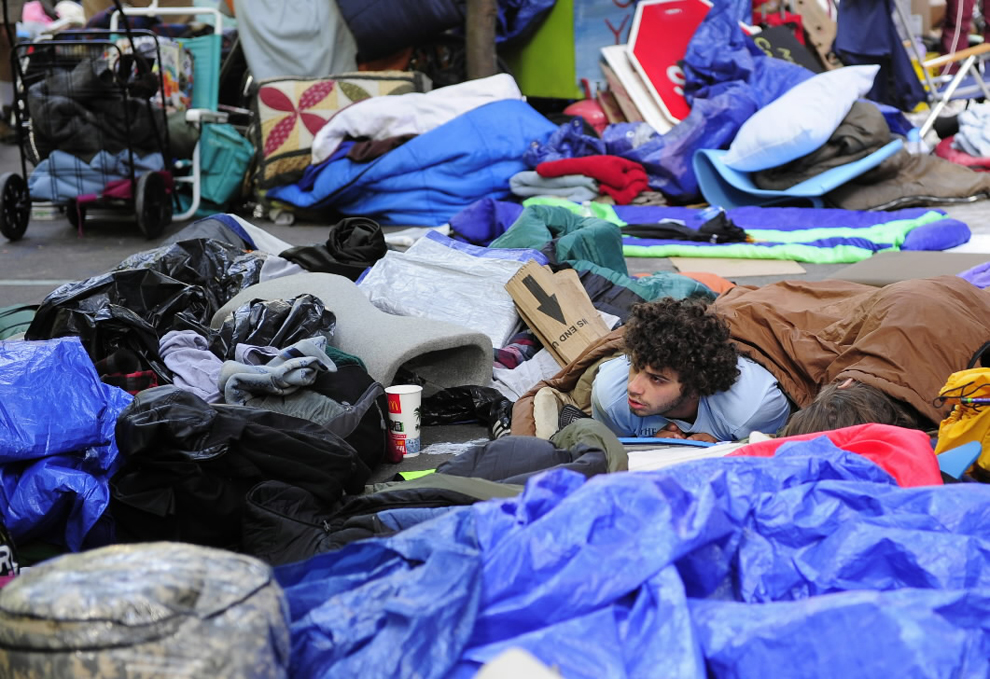This essay was originally published in N+1's Occupy! An OWS-Inspired Gazette

Emmanuel Dunand/AFP/Getty Images via The Big Picture
A Tumblr of user-submitted handwritten signs with bleak personal testimonies first captured the internet’s attention. Presented are the lives of real people, unmistakable hardships, ready to reblog and retweet. But implied—by the faces, the faces, the faces —is that to sympathize you must show up. This time a Facebook “like” is not enough.
There is something twisted and belittling about the momentary act of tapping on Tumblr’s like button — a heart icon — when you are looking at the face of someone who has itemized his debt in magic marker for you to calculate. How much we have and what we owe is what we are typically raised never to discuss openly in polite company. These images of persons denuded of financial mystery request from the viewer something just as human; not a thoughtless mouse click. To properly commiserate with the enormity of this curated series of individual misfortunes, one must in person participate.
Around the globe, the “99 percent” sloganing rings effortlessly. This is a generation accustomed to encapsulating arguments into 140 character messages. It is also a generation experienced in negotiating private entities for public means. Zuccotti Park’s tenuous standing as a privately owned public park seems an inevitable metaphor for the questions of free speech, assembly, and property rights posed by so many virtual spaces. Brookfield is like Facebook, Bloomberg like Zuckerberg: their threatened park closure is like the ever-present possibility that Facebook will suspend activist accounts and group pages used to plan rallies and activities, for vaguely specified reasons.
"We must occupy real and virtual spaces,” Reuters’ Anthony De Rosa tweeted, quoting an occupier at the second Washington Square park General Assembly. Without one there couldn’t exist the other.
Every morning the seemingly impossible occurs — the occupied territory remains in the hands of occupiers. Without Facebook, social networking would disperse to dedicated alternatives from Piratepad to Eventbrite. But modularly redistributing Zuccotti Park would destroy its momentum. An encampment of less than 24 hours is not a home. Living in the territory is what sets its example for the rest of the world.
Occupiers play chess with chess pieces and read books made of paper. They partake in activities the internet is said to be dematerializing. Part of the utopic vision of Zuccotti Park as a microcosm is that real and virtual worlds may more peacefully coexist.
Occupy Wall Street’s actual web presence —“unofficial de facto online resource” —is a lean website not much more advanced than what Indymedia provided a decade before it. But its simplicity offers replicability. In the first month, over a thousand cities have occupied, many with bare bones “Occupy” websites of their own.
A leaderless movement doesn’t have to scrimp on design elegance, as the evocative poster of dancer balancing on the Bowling Green Bull demonstrates. Occupy Wall Street is purposefully “bootstrapping,” as a Silicon Valley marketer would put it. Perfect is the enemy of done. Elsewhere transcribed minutes from GA assemblies are posted to a basic blog template. There are comments for people to fact check that seem mostly populated with #OWS trolls (“…Buck up people get off your whiny ass and get a job. A job is a job is a job, no matter what you do...”) Often slapdash, the transcripts are replete with typos, which isn’t of chief concern as one would expect each meeting was recorded over a plethora of Android and iPhone app options. Further documentation of meetings might be pieced together with Twitter and Flickr fragments.
The occupation is a gesture against the isolating experience of the screen-mediated online world. A need to experience the world for one’s self, to communicate with more than text. So many email threads and conversations over SMS go on, ceaselessly, over points that can be made instantly face-to-face. The “human mic” is not so tedious in comparison.
The “human mic,” after all, is acting like a retweet—a filter of redundancy; when it works best, you don’t hear things twice. This call-and-response is impossible to do while checking email at the same time.
How dizzying and science fictional the everyday absurdity of social media might have seemed in Seattle or A16. Back then, citizen journalists had to hurry back to an ethernet connection to upload images and file stories. Now, smart phones enable published testimony and imaging the very moment one bears witness.
Ten years ago, we interacted online based on protocols of face-to-face. Today we introduce ourselves to one another based on how we meet online—following interesting-looking strangers on Tumblr or Twitter. Maybe we’ve seen their faces already as tiny icons, friends of somebody else we know on the screen.

The state ban on face coverings enforced at demonstrations and occupations— the reason why you don’t see caucusing of Guy Fawkes masks in New York — is the real space equivalent of Google Plus and Facebook strictly enforced terms of service forbidding pseudonyms. However mandated, the generational shift toward “authenticity” online, owning one’s identity completely, is the culture that created the “We are the 99 Percent” Tumblr. The most powerful images come from the unmasked and de-anonymized, who share their grief of unemployment, student loans, the inability to afford healthcare — and the frustration in their eyes.
That isn’t to dismiss Anonymous’ — and thus 4chan’s — role in developing this movement. Zuccotti Park is an immersive experience. Its intricate LARP-like gameplay; the possibility to volunteer service to the first aid, sanitation, library, or media units regardless of experience; comes from the trickster spirit of decentralized web culture. Like the internet, Zuccotti Park offers the potential to assume any identity with knowledge and curiosity. Anyone can be anything in the occupied space — cooks, janitors, nurses, librarians, dreamers.

